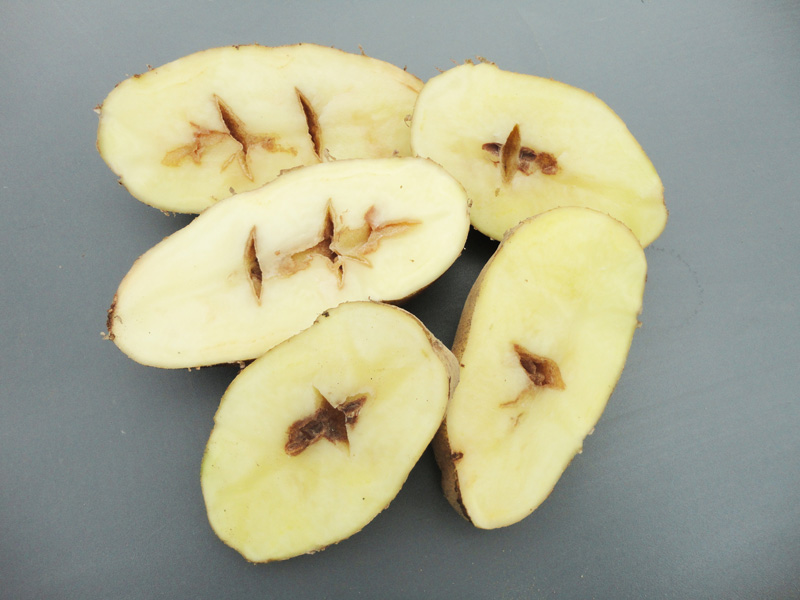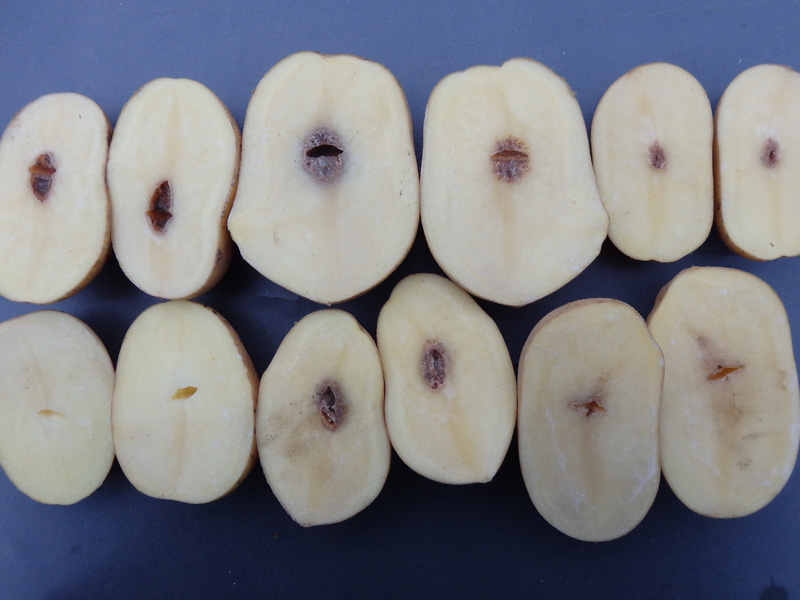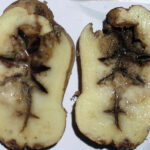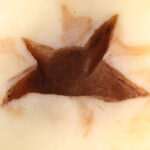English name: Hollow heart
Polish name: Pustowatość bulw
Perpetrators of the disease:
- abiotic factors (low temperatures, stress, uneven distribution of precipitation, potassium deficiency)
Gallery

Hollow heart. Variation in appearance depending on the occurrence time of the defect.
(photo by S. Wróbel)

Hollow tubers. Variation in appearance depending on the occurrence time of the defect.
(photo by J. Osowski)

Hollow tubers. Cavity appearance depending on the shape of the tuber.
(photo by J. Osowski)
- Pustowatość bulw wtórna infekcja przez bakterie (fot. J. Osowski)
- Pustowatość bulw. Charakterystyczny wygląd komory (fot. S. Wróbel)
- Pustowatość bulw. Wygląd jamy w zależności od kształtu bulwy (fot. S. Wróbel)
- Pustowatość bulw. Wygląd jamy w zależności od kształtu bulwy (fot. J. Osowski)
Characteristics and description of the disease
Hollow heart is an internal defect in potato tubers caused by abiotic factors, meaning those not induced by living organisms. Abiotic factors include temperature, uneven distribution of precipitation, prolonged periods of drought, and nutrient deficiencies.
This defect, along with brownish discoloration of the flesh, is among the most severe hidden defects in tubers intended for processing. In severe cases, it can result in the loss of approximately 40% of the tuber weight. Hollow heart occurs at various times during the growing season. Early development of hollow spaces appears as brown spots, about 1-2 cm in diameter (photo 1), caused by disruptions in enzyme activity. Cells and tissues dying due to abnormal enzymatic processes isolate the necrotic focus from the rest of the tuber with a cork layer, eventually covering the entire surface of the formed cavity (chamber). Hollow spaces developing later in the growing season lack such a brown zone. If the defect occurs early in the growing season (usually during tuber initiation), the cavity is located in the stolon-end part of the tuber; if later, it’s in the apical part (photo 2A, 2B, 2C).
The appearance and shape of the cavity caused by hollow heart vary not only depending on when it develops but also on the shape of the tuber. Cavities in round tubers resemble a plum seed or a star, while in elongated tubers, they are longitudinal or irregularly shaped (photo 3A, 3B). Typically, the formed cavity inside the tuber is lined with a cork layer protecting it from pathogenic infections (photo 4). However, internal rot may occur in humid conditions (photo 5).
Several factors contribute to the occurrence of hollow heart, with the most significant being:
- Low temperature for 5 to 7 consecutive days during tuberization.
- Excessive nitrogen fertilization, especially late in the growing season.
- Susceptibility of certain varieties, especially those with thick stolons.
- High humidity after a dry period.
- Excessive spacing between plants.
Prevention mainly involves agronomic practices, with key measures including:
- In regions where there is a risk of low temperatures and high humidity during tuberization, consider a slight delay in planting.
- Choose processing varieties that are resistant or have increased resistance.
- Adjust nitrogen fertilization according to the potato cultivation direction and the needs of the cultivated variety.
- Avoid cultivating highly acidic soils with low cation exchange capacity.
- Increase potassium fertilization.
Compiled by: Dr. Eng. Jerzy Osowski




